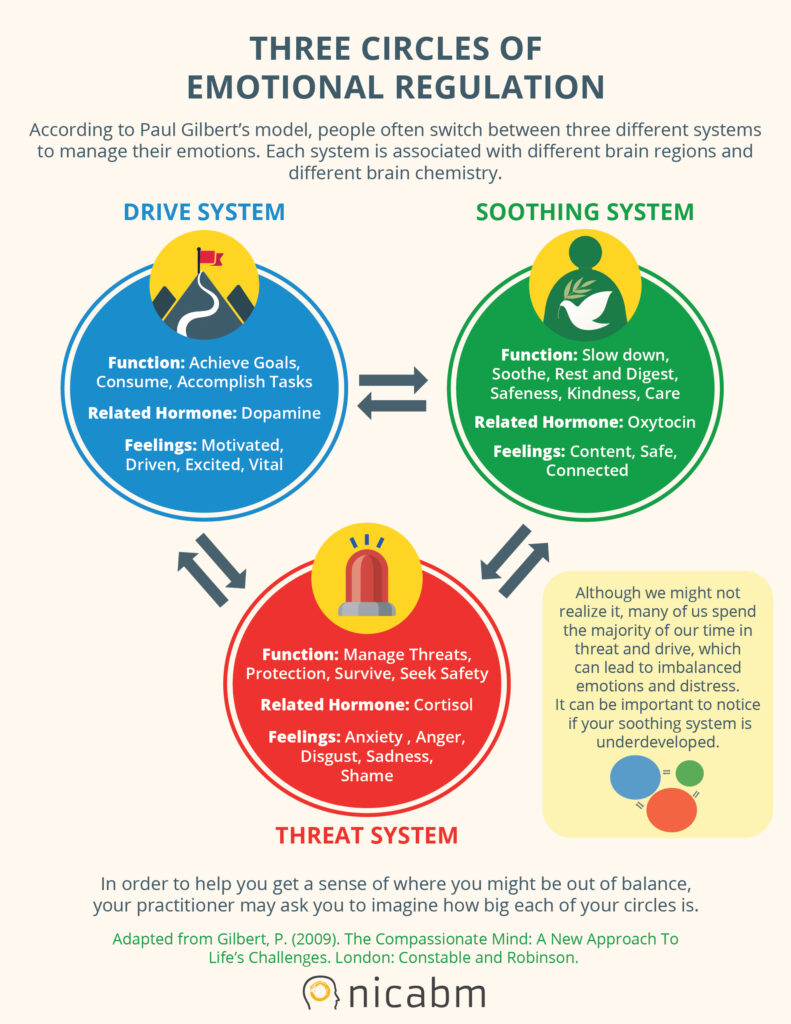Usefully seen alongside the work of Acceptance and Commitment Therapy (ACT), Compassion Focused Therapy (CFT), developed by Paul Gilbert, has much to add to the art of safe experimenting.
Like ACT, CFT is less concerned with a theory or a model and it is well connected to knowledge emerging from neuro-science.
CFT is good at linking Eastern philosophies and Western therapeutic practices seen in Cognitive Behavioural Therapy (CBT) and Martin Seligman’s perspective on positive psychology.
What is evidence in your therapy?
One thing that does bother me about the model is its concern for a science and ‘evidence-base’. Not only does this diminish the ‘art’ that is tucked away in CFT, but also the term ‘evidence-base‘ begs question: What is evidence? Martin Milton, a UK-based Counselling Psychologist at Regents College, London,had something to say about that in:
Milton, M. (2006) ‘Evidence-based Practice: Issues for Psychotherapy’, in D. Lowenthal and D. Winter (Eds) What is Psychotherapeutic Research? Karnac, London
For my part, I want you to use CFT, or any model, for that matter, as a ‘mirror’ – to look at yourself as you make meaning and practise the art of being different and doing differently.
The CFT approach shares with this website an interest in thinking-about-breathing as a helpful start when we want to make change. CFT refers to this experiment as “soothing rhythmic breathing” It adds a focus on diaphragmatic breathing; that is, belly or abdominal breathing.
I like the way it encourages us to “play with the speed of your breath until you find a comfortable, soothing rhythm of breath“. Controlled breathing is a practical activity offering a gateway into many ways in which any of us can ‘affect regulate’ …. provided it is used frequently, briefly and randomly (that is, not in a crisis or in the heat of the moment).
An experiment
Engage with thinking-about-breathing. This safe experiment is discussed on this page.
As you continue to think-about-breathing, focus on how your legs, or another part of your anatomy, is feeling now. On your out-breath imagine any tension in your legs and just notice it flowing down your legs and out of your body. Let the tension go on that out-breath.
As you breathe in, notice the energy that flows into and through your body. You can tense your leg muscles as you breathe in. Allow them to relax as you breathe out.
If you experiment with progressive relaxation you will find you can do this experiment with every part of your body – starting at the very top, with your skull, and working down to your smallest pinkie.
Finish such experiments slowly; try a slow count from 1 up to five. It might help. Also, you can move your body around a little with your in-breath. Notice how your body feels as you do this.
There are other comments of safe experiments used when we have experienced trauma; see this page.
Creating a calm or safe place before bringing up traumatic memories
Another practice associated with CFT and, I should say, a number of therapies, including hypnosis, is the creation of calm, in a safe place of your choosing. I have said more about this elsewhere.
All these practices, and other meditative routines, can help us to become more aware of our “compassionate self”, as well as find some compassion for others. Chris Irons did an impactful training for PESI on ways to explore our compassionate self. I’d recommend you look out that name for more information and some very practical ideas.
In particular, I’d advise reading up on the CFT description of the three systems humans use to manage their emotional states. This is found in the next illustration. It should be helpful in the design of safe your experiments.
The CFT systems are
- the Threat system – where our motivation is to simply survive, attention is threat-focused, driven by fear, anxiety, thoughts of danger, and the fight or flight system.
- the Drive system – where our motivation is to achieve/win, attention is given to goals and finding the advantage; it is concerned with motivation, arousal, and focus.
- The Care/Soothing system – where our motivation is to look after, or be looked after; to soothe or be soothed and foster empathy toward other people. It is concerned with caring, soothing, safety and calmness.
The three systems in Compassion Focused Therapy
These are illustrated in a picture, below. Take time to record how the Threat, Drive and Care systems have evolved in your own life. You can return to your notes on your Road Map to help here.
What do your circles look like? The illustration below offers an ‘ideal’ view of the three systems. As with Transactional Analysis, effective safe experiments help you draw your circles. Rarely will they be all the same size and just touching!
Here’s an experiment. Ask your self: how might one or more circle be just a little bit different? How might they relate to one another in a different way? This safe experiment is described in more detail on this page.

For more information on Compassion Focused Therapy (CFT) take a look at this slide presentation on this link.
I had a small, safe experiment sent me that you might like to try. Compassion may involve a combination of forgiveness and affirmation. Forgiveness is not easy to offer, and I suspect some of us find forgiving ourselves may be particularly difficult.
A safe experiment in forgiving ourselves
Some traumatic memories promote guilt, as well as fear. It is easy to blame ourselves for what went wrong.
There is an experiment that can talk to our ‘inner guilt’, as it was put to me. The affirmation offered to me was: “I had the right intention at the time“.
If necessary, describe the error or mistake that you believe you made. Do not do this if it triggers recall of events, as though you were back there. The aim of any description of an incident, NOW, is to look any of your actions ‘in the eye’. It may be possible for you:
- to see your actions in a different light – looking back to then, from now.
- to see other outcomes that emerged from the defeat your experienced so you can…
- …… look forward, rather than backwards.
- It may help to remind yourself about the ‘scenic route‘ where I make the point the small defeats can, in time, become small victories even if small victories can, in time, look more like defeats.
Monitoring past events and present responses
This experiment using Affirmations can help if you can use Subjective Units of Discomfort (SUDS). The help record the frequency and intensity of any feeling you have about your actions.
Does this visual help with identifying feelings and the SUD level? Using it can help to just notice the changes. Most feelings go up or down; few stay put for any length of time.
SUD Emoticons
GREEN is 1/2
RED is 9/10

Bear in mind that any affirmation I have offered, above, may ‘feel’ false when first spoken. That’s because the affirmation is most often a belief and us humans do not change our beliefs easily!
So, for a moment you may not believe in the affirmation. Even so, just notice if, over time, you can change your belief.
If you do this type of experiment, I’d recommend you to revisit the notion of ‘neuro-plasticity’ as well as the work by Stephen Porges and Dan Siegel. Notice how common connections are emerging from neuro-science and ways of doing therapy.
If you are interested in formal research into ‘compassion’, use this link may expand your knowledge. I expect to add more in due time.
